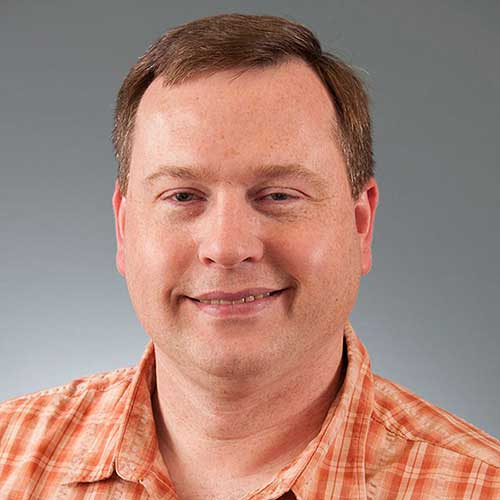AUM Faculty & Staff
Directory


John Hutchison
Associate Professor | College of Sciences
Ph.D. (2007) Organic Chemistry, University of Arkansas, Fayetteville, AR
B.S. (2000) Chemistry, University of Southern Indiana, Evansville, IN
Dr. John Hutchison is an Associate Professor in the AUM Department of Chemistry. His area of expertise is Synthetic Organic Chemistry. His research interest lies in the synthesis of structurally interesting and/or biologically active organic molecules. Graduate and post-doctoral work involved the development of synthetic strategies towards the synthesis of eupomatilone-6, sclerophytin A, cladiell-11-ene-3,6,7-triol, antascomicin B, organometallic Ni and Pd-complexes, and CdSe nanoparticles. While at AUM his undergraduate research students have completed the total synthesis of three natural products gymnoascolide A, eutypoid A, and microperfuranone. Current undergraduate research projects involve short-syntheses of biologically active natural products and structure activity studies of antibacterial C-4 and C-5 substituted butenolides. Dr. Hutchison enjoys working with AUM students in both the classroom and laboratory. He is a good research mentor and he is an outstanding life guide for students.


Marilyn Jefferson
Administrative Associate | College of Sciences


Nikita Johnson
Administrative Coordinator | College of Sciences


Fatih Karabiber
Assistant Professor | College of Sciences


Duk (Daniel) Kim
Department Chair; Professor | College of Sciences
Ph.D. (2003) Chemistry, Florida International University
MS (1987) Chemistry, Yonsei University, Seoul, Korea
BS (1985) Chemistry, Yonsei University, Seoul, Korea
Dr. Daniel Kim is an organic Chemist. His current research interests lie in using ultrasound to accelerate slow chemical reactions, removal of resisting pollutants in polluted water. He applies ultrasound to measure the antioxidant capacity of natural materials. His background experience has a broad spectrum from synthesis of unusual organic compounds, nuclear chemistry using nuclear reactors or particle accelerators, environmental remediation using advanced oxidation technologies, and modification of solid materials using accelerated particle beams. Dr. Kim is the Chemistry Chair and advisor of the Chemistry Club.


Vanessa Koelling
Assistant Professor | College of Sciences
Ph.D. University of Georgia (2008), Genetics
B.A. Reed College (2000), Biology
Bio: Dr. Vanessa Koelling is an Assistant Professor in the Department of Biology and Environmental Science. She is a plant evolutionary biologist, which means that she studies how plant populations change over time in response to new environmental conditions. Within the field of evolutionary biology, she is particularly interested in the evolution of plant mating systems, the mechanisms of plant speciation, and in plant evolutionary genetics. Her work aims to understand which evolutionary mechanisms are most important in plant mating system evolution and speciation, and to understand the causal genetic changes underlying plant adaptations. She currently studies these topics using the common yellow monkeyflower (Mimulus guttatus), a wildflower endemic to the Western United States with many features that make it an ideal system for the study of evolution. She has also begun a new project to study the population genetics, ecophysiology, and evolution of two of Alabama’s native azaleas (Rhododendron cumberlandense and Rhododendron prunifolium). In addition, she is interested in eventually expanding her research into other Southeastern plants.
Dr. Koelling has published her work in distinguished scientific journals, such as Heredity, the American Journal of Botany, and The American Naturalist. She is a member of the Society for the Study of Evolution and the Botanical Society of America. (Scholar page)
Dr. Koelling is also an experienced teacher who has taught a range of introductory and specialized courses. She especially enjoys teaching topics in evolution, genetics, and applied bioinformatics. She incorporates inquiry-based and active-learning methods into her courses, and continually seeks new ways to engage and motivate students in her classrooms.


Tim Kroft
Associate Professor | College of Sciences


Olcay Kursun
Assistant Professor | College of Sciences


Douglas Leaman
Dean | College of Sciences


Enoch Lee
Associate Professor | College of Sciences
Enoch Lee is Department Head and an associate professor in the Department of Mathematics in the School of Sciences. His mathematical research interests include rings, modules, near-rings, semigroups, universal algebra, radical theory, number theory, cryptology, coding theory, etc. He was also a wireless engineer specializing IP traffics. Later he became an optical network system engineer, specializing MultiProtocol Label Switching (MPLS) control plane. He has done research on Voice over IP (VoIP), streaming audio and video, Internet applications traffic characteristics, (G)MPLS, etc. He is also interested in applying computing technology such as distributed computing (as a form of high performance computing) in solving mathematical problems.


Wei Li
Lecturer | College of Sciences


Ting Lo
Math Lab Coordinator | College of Sciences
Dr. Lo earned his Ph.D. in Electrical Engineering from the Auburn University in 2003. After graduating from Auburn, he moved back to Montgomery, AL and served as an adjunct instructor with Trenholm State Community College since 2004. He was taught mathematics, physics and electronics course during those years.
Starting in 2013, Dr. Lo joined the Chemistry department at AUM. He teaches Physics and Physical Science. Before assuming the lab coordinator position, he taught the mathematics courses for the math department.
Dr. Lo enjoys playing Sudoku and working on computer hardware during spare time.

